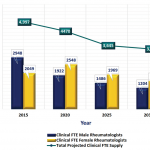The ACR and the ARHP have a long, rich history of collaboration, spanning close to 25 years together. Our predecessors saw the value of an interprofessional team and having an organization that brings together a vast number of constituencies. The result was these two organizations coming together in 1994 when the ARHP became a division of the ACR to meet the needs of all rheumatology professionals.
Our broad constituency includes clinicians in academic and private practice, physician scientists, rehabilitation professionals, researchers, practice managers, pharmacists, social workers, nurses and advanced practice professionals (e.g., nurse practitioners/physician assistants), to name a few. The ACR vision embodies the value of this diverse team: “As the leading authority on and trusted partner of rheumatology professionals, the ACR will continually advance the specialty and the future of rheumatology.” This unique partnership stands out as one of a handful of interprofessional organizations representing all constituents involved in team-based care.
Reflecting on the history of our organizations, we continue to see many of the same challenges faced by our predecessors: funding for training, workforce shortages, research funding, patient access, reimbursement, practice support needs and much more. Although we have continued to thrive, many of these issues seem more daunting than ever. How our organization rises to meet these needs is reflected in the themes of the ACR 2017–2022 Strategic Plan: data-driven approaches, increased membership in targeted categories, education enabled by technology (how, where and when desired), personalized content and targeted member interactions, and sustained future of rheumatology. The ACR/ARHP, along with the Rheumatology Research Foundation, have worked to meet these challenges and themes through the combined efforts of our diverse volunteer-led committees, fundraising and involvement in advocacy.
Data-Driven Approach
In 2014, the Rheumatology Informatics System for Effectiveness (RISE) registry launched and now includes nearly 9.5 million patient encounters (of which more than 2.5 million are RA encounters) encompassing all ages and rheumatic diseases. Under the Medicare Access & CHIP Reauthorization Act (MACRA), rheumatologists can choose various reporting mechanisms to participate in the Merit-Based Incentive Payment System (MIPS), and it’s important to note that—among the options—MACRA created incentives for providers to report via registries—including significant bonuses for reporting via a Qualified Clinical Data Registry (QCDR), such as RISE. 2017 was the first year for MIPS performance data submission, and participation via RISE delivered outstanding results. Every member who completed a full submission via the RISE registry last year qualified for financial incentives. And the majority of these providers received a perfect score and qualified for the largest bonuses.



